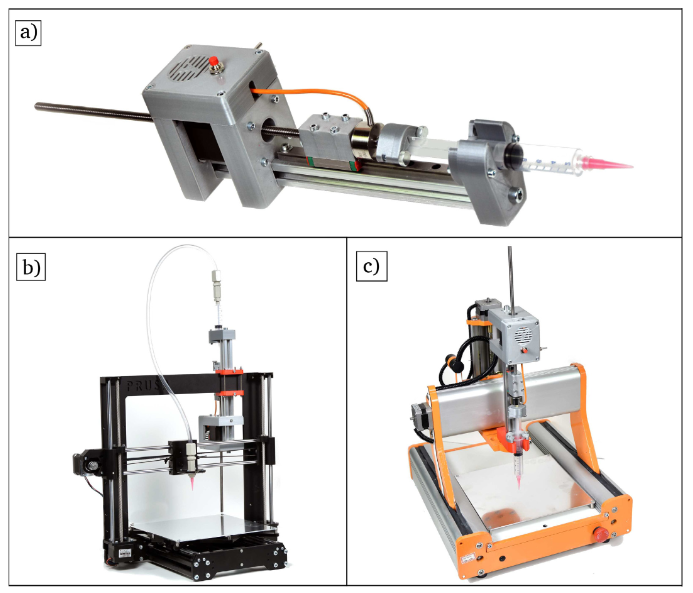In the recently published ‘Ystruder: Open source multifunction extruder with sensing and monitoring capabilities,’ Ville Klar, Joshua M. Pearce, Pyry Kärki, and Petri Kuosmanen explore the use of syringe pumps for projects requiring materials to be extruded at a specific rate. The use of syringes continues to trend upward in labs due to open-source accessibility and affordability—along with offering further potential for innovation. In this study, they have developed a new pump design called the Ystruder.
Because there are budgetary concerns in many research projects, reducing cost is imperative to many projects that require high-performance equipment—in developing areas especially. Numerous open-source hardware (OSHW) syringe pumps have been created in the past ten years via 3D design and FDM 3D printing.
Today, even more, ‘feature-rich’ syringes are being produced, and for this study, the Ystruder was created as a further refinement to pump designs. Also meant to expand the number of viable applications, the Ystruder is both compact and lightweight and has dual uses as either a syringe or extruder to be mounted on a basic stand or 3D printer frame. The controls can also be integrated into other devices like robotic arms. Other mechanical parts can be 3D printed, with open-source printed circuit boards (PCBs) fabricated easily and affordably too.

a) The Ystruder syringe pump extruder, b) Ystruder mounted on a Prusa I3 style 3D printer using tubing, and c) Ystruder mounted on a 43 mm-diameter spindle mount.
While the default syringe for the Ystruder is a standard 10 mL, many other sizes and types can be used, and are easily attached and removed. Different mounts and attachments can be fabricated, and open-source, Python-based software is also available.
“The use of luer-lock syringes enables efficient testing of various orifice sizes,” stated the authors. “In contrast to most conventional syringe pumps, the Ystruder features load sensing capabilities. The piston load measurement makes it possible to characterize the extrudability of various liquids directly during extrusion or 3D printing. Users can, therefore, assess and identify suitable extrusion parameters more efficiently.”
The authors include:
- Design file information
- Bill of materials
- Tools required and build instructions
- Step-by-step assembly
For validation in 3D printing, the researchers attached the Ystruder to a CNC machine-frame, testing parameters and printing, leaving them to note that the syringe pump ‘performs well,’ as well as functioning as a paste extruder.
“Ystruder has the potential to be used in demanding applications such as 3D bioprinting. While the design is already sufficient for a wide variety of extrusion tasks, there are both hardware and software modules that require additional development. We distinguish four key areas of improvement, error quantification, control development, interface improvement and extension of modularization,” conclude the researchers.
“The design can already be easily modified by e.g., replacing the stepper motor with a finer pitch version or upgrading to a higher current capacity stepper motor driver. The sizing information provided in the Supplementary information is intended to accommodate adapting the design to different extrusion requirements.”

Errors of displacement, extruded volume, flow rate and speed, standard error of the mean shown in black.Fig. 10.Displacement, extruded volume and piston force of the Ystruder using different kinematic viscosities (cSt), flow rates (mL/min) and syringe diameters (mm). a) 1000 cSt, 1 mL/min, 1.8 mm b) 1000 cSt, 1 mL/min, 0.5 mm, c) 10000 cSt, 0.2 mL/min, 0.5 mm, d) 1000 cSt, 0.2 mL/min, 0.5 mm.16V. Klar et al./HardwareX 6 (2019) e00080

3D prints, original CAD-model at the top and printed structure at the bottom a) Suzanne-mesh from Blender, Acrylic paste b) Honeycomb structure, heat resistant silicone c) The letter A, ceramic paste material.
While new 3D printers come on the market continually these days, along with software, hardware, and a variety of new materials, additional parts such as syringes and nozzles are offered too from bioprinting syringes to acoustic nozzles, to 3D syringe delivery systems, and more.
What do you think of this news? Let us know your thoughts! Join the discussion of this and other 3D printing topics at 3DPrintBoard.com.
[Source / Images: ‘Ystruder: Open source multifunction extruder with sensing and monitoring capabilities’]
Subscribe to Our Email Newsletter
Stay up-to-date on all the latest news from the 3D printing industry and receive information and offers from third party vendors.
You May Also Like
Gorilla Sports GE’s First 3D Printed Titanium Cast
How do you help a gorilla with a broken arm? Sounds like the start of a bad joke a zookeeper might tell, but it’s an actual dilemma recently faced by...
Nylon 3D Printed Parts Made More Functional with Coatings & Colors
Parts 3D printed from polyamide (PA, Nylon) 12 using powder bed fusion (PBF) are a mainstay in the additive manufacturing (AM) industry. While post-finishing processes have improved the porosity of...
$25M to Back Sintavia’s Largest Expansion of Metal 3D Printing Capacity Since 2019
Sintavia, the digital manufacturing company specializing in mission-critical parts for strategic sectors, announced a $25 million investment to increase its production capacity, the largest expansion to its operations since 2019....
Velo3D Initiates Public Offering in a Bid to Strengthen Financial Foundations and Drive Future Growth
Velo3D (NYSE: VLD) has been among a number of publicly traded 3D printing firms that have attempted to weather the current macroeconomic climate. After posting a challenging financial report for 2023,...

































